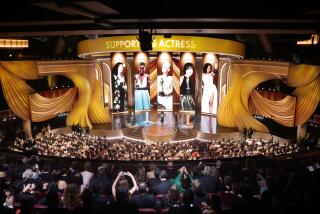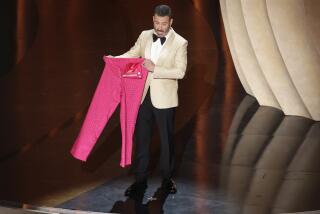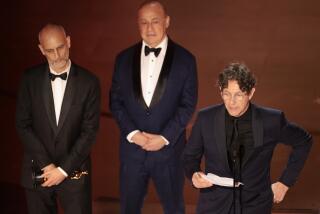Note to Oscars: Get real
IT’S now painfully obvious that the Oscars need what nearly every aging star in Hollywood has already had -- a face-lift.
The ratings for the show couldn’t have been any worse if they’d been stuck with all of Jay Leno’s strike-show guests instead of Jon Stewart and Co. The numbers hit rock bottom, down a million viewers from 2003, the show’s previous low ebb, and that was right after a war started. Even worse, the ratings for younger viewers dropped off a cliff, falling almost 25% from last year’s telecast. The film academy elders should be very, very worried. If Fox doesn’t have a best picture nominee next year, they’ll probably cook up a nighttime NASCAR special hosted by Jessica Alba, run it opposite the Academy Awards and do some serious damage.
By now you’ve probably heard all the same excuses. The show was hurt by a host of downbeat, little-seen movies. The show was damaged by the bad vibes from the writers strike. Stewart doesn’t cut it with a mass audience.
Phooey. The writers strike didn’t hurt movie box office, so why would it damage the Academy Awards? The academy could’ve given 10 nominations to “Transformers,” but does anyone really think having Shia LaBeouf on stage would turn the Oscars into a youthquake? As for Stewart, who seemed slightly defanged for my tastes, whether a host kills or bombs doesn’t lure anyone new to watch the Oscars any more than hiring a replacement for Katie Couric would ever get me to watch the “CBS Evening News.”
That brings us to the academy’s real problem. Like the evening news broadcasts, the Oscar is a relic, a cobwebby holdover from a bygone media age when Big Events earned Big Audiences. Those days are going, going, gone. The Grammys’ ratings were down, the Emmys were down, the Golden Globes would’ve been down even if it hadn’t been eviscerated by the strike.
Younger audiences just don’t believe in appointment viewing anymore. Their lives are full -- they don’t stop what they’re doing to watch Oscar night. The only show that’s held its ratings is the Super Bowl, which had at least three things the Oscars lacked: inventive, state-of-the-art production; a whole second show inside of the show -- splashy new commercials, which are often more involving than the game itself; and a far more suspenseful fourth quarter. Is there really anyone in America who didn’t get best picture, best director and three of the four acting awards right in their Oscar pool?
In an era where everyone’s lives are twice as busy and their attention span has been cut in half, it is simply suicidal to put on a pokey three-hour-plus award show. As the legendary B-movie master Sam Arkoff once put it, when trying to sell a film that stunk: “If you can’t make it a better picture, you can always make it a shorter picture.”
The academy should heed his advice. Here’s how we watched the Oscars in my household: We TiVo-ed the broadcast, came back from Little League practice, hopped in bed with some snacks and zapped through the commercials, the musical numbers and most of the craft awards, giving our full attention to Stewart’s routines, the clip compilations and the big awards and acceptance speeches, starting with best animated feature. Total elapsed time: one hour, 45 minutes, tops.
Our family’s version of the Oscars, thanks to the magic of TiVo, didn’t drag a bit. If academy chieftain Sid Ganis is going to staunch the bleeding, he needs to put the telecast under the knife. Although I’m sure it will cause a firestorm inside the academy, the technical awards -- sound editing, sound mixing, visual effects, makeup and costume design -- have to go. No one outside of the academy wants to hear acceptance speeches from people they’ve never heard of, no matter how heartfelt. The Oscars may have once been a celebration of craft, but the world has changed. Today’s audience wants a horse race. The show is just bad TV.
The same goes for those cringe-inducing renditions of the best original songs. With the exception of a wonderfully spare rendition of “Falling Slowly” from “Once,” they were all massively overproduced, drenched in so much glitz that they lacked any emotional resonance. I mean, who did the choreography -- Michael Bay? And speaking of Ganis, why is the academy president on camera, taking up valuable time explaining arcane voting procedures? It’s just dead air.
There is plenty of precedent for streamlining the Oscar telecast. Just watch the Grammys. In a typical telecast, the Grammys have roughly 20 musical performances while giving out 10 actual awards. The other 100-odd Grammys are presented earlier in the day at a pre-award show with presenters, acceptance speeches and a full audience. As an experiment, this year’s pre-show was webcast on Grammy.com with the idea of expanding it into a bigger event in the future.
MTV stages a Web simulcast for its Video Music Awards, with separate hosts situated backstage, giving fans watching on the Internet a chance to see some of the backstage action.
These are the kinds of innovations the academy desperately needs to embrace. It should have a full-on Web broadcast, anchored backstage by someone who’s been in a Judd Apatow movie, with live remotes from Oscar parties around the country. The technical awards, beefed up with appearances by younger actors and filmmakers as presenters, would have enough appeal to merit their own telecast, perhaps on a movie channel like AMC or Turner Classic Movies the night before the Oscars. Freed from the weight of academy ceremony and tradition, they could serve as a proving ground for fresh ideas and new talent that could be incorporated into future Oscar telecasts.
Having a separate, less formal tech ceremony would allow the academy to experiment with new ideas, whether it’s trying a Web simulcast, showing user-generated parodies of Oscar films or launching a Web-sponsored “pick the host” contest. The show could add star appeal by doing interviews with stars preparing for the big show the following night, playing fun clips from the Independent Spirit Awards or having a live remote from an industry Saturday-night party.
More important, some of this informality needs to filter into the actual Oscars. The most obvious place to take the TV audience is backstage. People yearn to get behind the velvet rope, so why not offer frequent glimpses of what’s going on backstage during the show? The host is only on camera for a small percentage of the three-plus hours. Wouldn’t everyone want to see what Jon Stewart is up to backstage between his official duties?
Today’s audience loves being inside the bubble. The NBA regularly mikes players and coaches, letting us eavesdrop on the coach’s locker room exhortations and the players’ jokes and conversations, replaying the best bits minutes after they’ve happened. If the image-conscious NBA can do it, surely the Oscars could let us have a feel of what’s going on in the green room too.
When it comes to live programming, there is no better TV in America today than what you see every week on ESPN and Fox Sports. It’s where practically all the best innovation and new ideas come from. As anyone who’s ever been to the academy’s nominee lunch will attest, the Oscars’ creative team is long in the tooth. With all due respect, it’s time for some new blood.
I know the academy’s attitude about embracing change is akin to Cuba going from Fidel to Raul, but it’s time for the Oscars to enter the real world. I’ve always defended the academy’s right to reward movies for their true art, no matter how lacking in box-office appeal the films may be. But the academy no longer has the luxury of clinging to a variety show with the same style of presentation and camera placements you could’ve seen on “The Carol Burnett Show” 30 years ago -- except that Carol Burnett was funny.
The academy should ask ABC to loan them a top-notch production team from ESPN and see if they can’t visually revamp the show. It needs serious plastic surgery, not just a little Botox.
--


